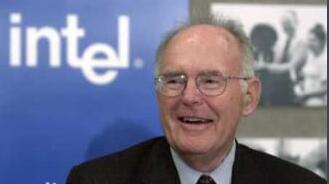Moore's Law was proposed by Gordon Moore, one of Intel's founders.
When the price is constant, the number of components that can be accommodated on an integrated circuit will double every 18-24 months, and performance will double. In other words, the performance of computers that can be bought for every dollar will more than double every 18-24 months. This law reveals the speed of advances in information technology.
Although this trend has been going on for more than half a century, Moore's Law should still be considered observation or speculation, not a physical or natural law. The law is expected to continue until at least 2015 or 2020. However, the updated growth of the international semiconductor technology roadmap in 2010 has slowed down at the end of 2013, and the transistor density is expected to double every three years.

First, the origin of Moore's Law:
Moore's Law is the founder of Gordon Moore, one of the founders of the famous chip maker Intel. The rapid development of the semiconductor manufacturing industry from the late 1950s to the beginning of the decade led to the introduction of Moore's Law.
As early as 1959, the famous American semiconductor manufacturer Fairchild first introduced a planar transistor, followed by a planar integrated circuit in 1961. This planar manufacturing process uses a so-called "lithography" technique to form components of a semiconductor circuit, such as diodes, transistors, resistors, and capacitors, on a silicon wafer that is flattened. As long as the precision of "lithography" continues to increase, the density of components will increase accordingly, which has great potential for development. Therefore, the planar process is considered to be "the entire semiconductor industry bond" and is the technical basis for the advent of Moore's Law.
On April 19, 1965, Moore, who was the director of the research and development laboratory of Fairchild Semiconductor, was invited to write an observation and comment report for the 35th anniversary of "Electronics" magazine. The title was: "Let the integrated circuit fill more element". Moore should predict the development trend of the semiconductor component industry in the next decade. According to his calculations, by 1975, on a single silicon chip with an area of ​​only a quarter of an inch, it would be possible to intensively 65,000 components. He made this inference based on the linearity of the complexity of the device (the circuit density is increased and the price is reduced) and time. His original words are as follows: "The complexity of the lowest component price is increased by about one each year. It can be convinced that this growth rate will continue to be maintained in the short term, even if it is not accelerated. In the longer term, the growth rate should be slightly fluctuating, although there are good reasons to prove that this growth rate It has remained almost constant for at least the next decade." This was the original prototype that was later called Moore's Law.
Second, the amendment of Moore's Law
In 1975, Moore presented a paper at the IEEE International Conference of the International Telecommunication Union. According to the actual situation at the time, Moore re-examined and revised the growth rate of “density every yearâ€. According to Moore’s interview with an editor (Scientific American) in September 1997, he changed the word “doubled every year†to “every two years,†and stated that he never said "Double every 18 months."
However, according to some media on the Internet, shortly after Moore’s paper was published, some people revised their predictions to “the density or capacity of semiconductor integrated circuits doubled every 18 months, or four times every three yearsâ€. Some even listed the following mathematical formula: (circuit multiplier per chip) = 2 (year - 1975) / 1.5. This statement has since become the "consensus" of many people and has been passed down to the present day. Moore's own voice, whether it was the original "every year of the map" or later revised "doubled every two years" was overwhelmed, and now little is known.
History has made a big joke with people: the Moore's Law, which is widely circulated at present, is not Moore's own statement!

Third, the verification of Moore's Law
Is Moore's Law inaccurate? Let us first look at a few specific data. In 1975, in an emerging charge-loading device memory chip, it did contain nearly 65,000 components, which is surprisingly consistent with the predictions of Moore a decade ago! According to statistics released by Intel Corporation, the number of transistors on a single chip increased from 2,300 on the 4004 processor in 1971 to 7.5 million on the Pentium II processor in 1997, and increased by 3,200 times in 26 years. We might as well make a simple verification: if Massager himself "doubles every two years", it should include 13 doubling cycles in 26 years. The number of components integrated on the chip should be increased by 2n times after each cycle. (0 ≤ n ≤ 12), so the number of components should be increased by 212 = 4096 times after the 13th cycle, that is, 26 years later. As a prediction of the development trend, this is quite close to the actual growth multiple of 3200 times. If the 18-month cycle is repeated by others, the two are far apart. It can be seen that in the long run, it is still Moore’s own statement that is closer to reality.
Some people also examine the correctness of Moore's Law from the three major elements of personal computers (PCs) - microprocessor chips, semiconductor memory and system software. On the microprocessor side, from 8086 and 8088 in 1979, to 80286 in 1982, 80386 in 1985, 80486 in 1989, Pentium in 1993, PentiumPro in 1996, and Pentium II in 1997. Prices are getting lower and lower, and every update is a direct result of Moore's Law. At the same time, the internal memory capacity of the PC has been expanded from the earliest 480k to 8M, 16M, which is more consistent with Moore's Law. In terms of system software, the size and function of the system software are greatly limited due to the limitation of storage capacity. As the memory capacity grows exponentially according to the law of Moore's Law, the system software is no longer limited to a small space, and it contains The number of lines of program code has also increased dramatically: Basic source code was only 4,000 lines in 1975 and developed to about 500,000 lines in 20 years. Microsoft's word processing software Word, the first edition of 1982, contained 27,000 lines of code and increased to about 2 million lines in 20 years. Some people plotted the speed of their development and found that the scale and complexity of software grew even faster than Moore's Law. The development of system software has in turn increased the demand for processors and memory chips, thus stimulating the faster development of integrated circuits.
What needs to be pointed out here is that Moore's Law is not a mathematical or physical law, but an analysis and prediction of the development trend. Therefore, whether it is a textual expression or a quantitative calculation, it should allow a certain margin. In this sense, Moore's prophecy is quite accurate and valuable, so it will be recognized by the industry and has a huge response.
4. Variants of Moore's Law
The resounding reputation of Moore's Law has led many people to follow the way of expressing it, thereby deriving and multiplying multiple versions of Moore's Law, such as:
Moore's second law: Moore's Law has been proposed for 30 years, the performance of integrated circuit chips has indeed been greatly improved; but on the other hand, Intel executives began to notice that the cost of chip production plants is also increasing accordingly. In 1995, Intel Chairman of the Board of Directors Robert Noys foresees that Moore's Law will be constrained by economic factors. In the same year, Moore wrote in the Economist magazine: "What makes me most worried now is the increase in cost, ... this is another index curve." His statement is called the second law of Moore.
New Moore's Law: In recent years, the emergence of the "new Moore's Law" in the domestic IT professional media refers to the increasing speed of the number of Internet-connected hosts and the number of Internet users in China, which is about doubled every six months! And experts predict that this trend will continue in the next few years.

5. The end of Moore's Law
Moore's Law has been around for nearly 40 years. It is not surprising to see that the level of semiconductor chip manufacturing processes has increased at a dazzling rate. At present, Intel's Pentium 4 microprocessor chip has a clock speed of 2G (1 2000M). In 2011, it will launch a chip containing 1 billion transistors and executing 100 billion instructions per second. People can't help but ask: Can this incredible rate of development continue indefinitely?
Without the need for complex logical reasoning, it can be known that the geometry of components on a chip can never be reduced indefinitely, which means that one day, the number of components that can be integrated per unit area of ​​the chip will reach its limit. The question is just what this limit is and when it is reached. Experts in the industry have predicted that the growth rate of chip performance will slow down in the next few years. It is generally believed that Moore's Law can be applied for another 10 years or so. The factors that restrict it are technology and the economy.
From a technical point of view, as the line density on the silicon wafer increases, its complexity and error rate will also increase exponentially, and it will become almost impossible to conduct comprehensive and thorough chip testing. Once the width of the line on the chip reaches the order of nanometers (10-9 meters), it is equivalent to only a few molecules. In this case, the physical and chemical properties of the material will change qualitatively, so that the semiconductor device using the current process cannot In normal work, Moore's Law is about to reach its end.
From an economic point of view, as stated in the above-mentioned Moore's second law, a chip factory is currently being built between US$2 billion and US$3 billion. When the line size is reduced to 0.1 micron, it will increase to 10 billion US dollars, which is greater than a nuclear power plant investment. Because they can't afford the money, more and more companies are forced to withdraw from the chip industry. It seems that Moore's Law will last for another ten years, and it is not easy.
However, some people look at the problem from a different perspective. Dan Linqi, president and CEO of CyberCash in the United States, said, "Moore's Law is about the laws of human creativity, not the laws of physics." People with similar views also believe that Moore's Law is actually a law about human beliefs, and when people believe that something can be done, they will try to achieve it. When Moore first presented his observation report, he actually gave people a belief that the development trend of his prophecy will continue.
Wuxi Lerin New Energy Technology Co.,Ltd. , https://www.lerin-tech.com